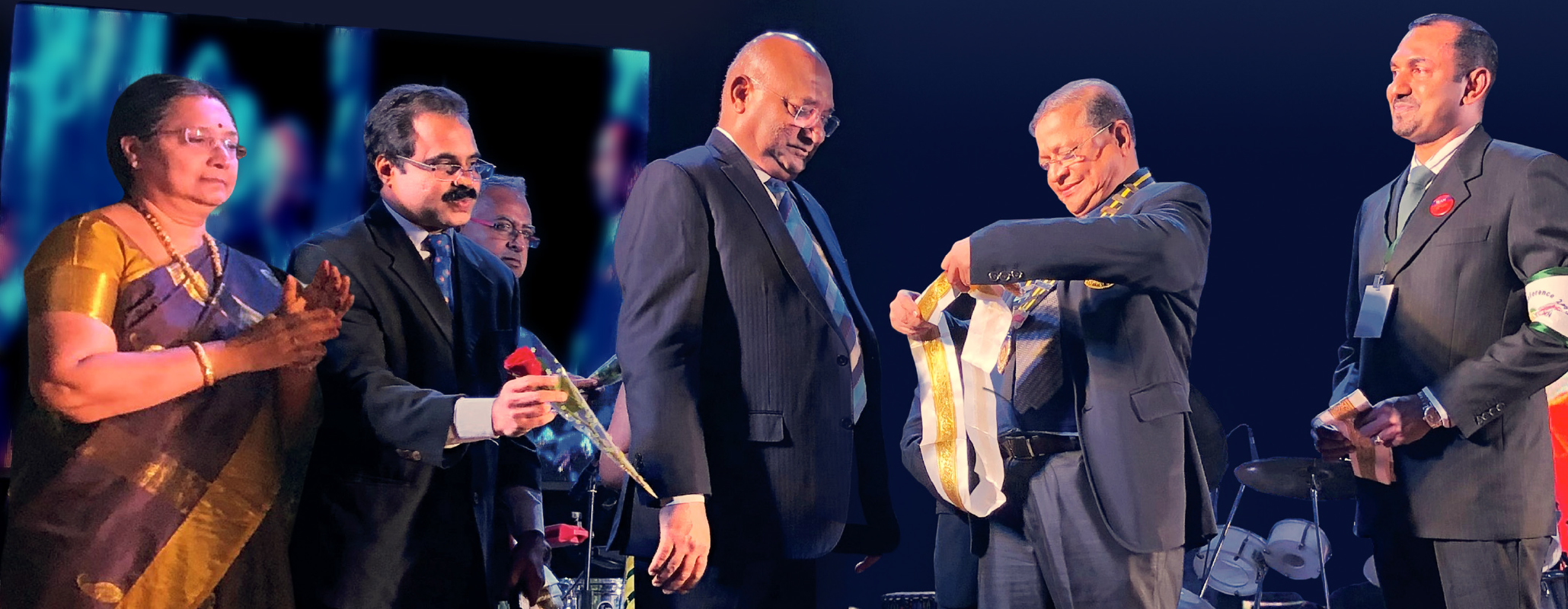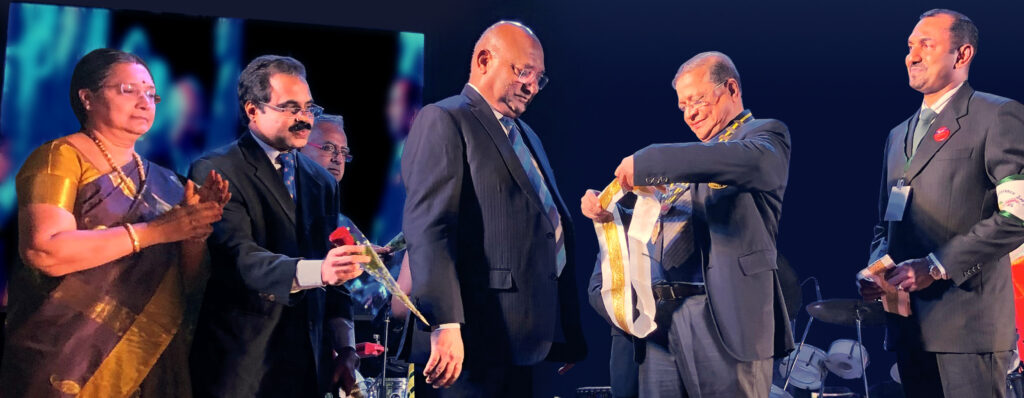One of the best things about leadership positions in Rotary was that most of these were confined to one year and rightly so, said RIDE Bharat Pandya, addressing Qalb, the conference of RID 3202 in Wayanad, Kerala. But this could be a huge negative too, because “every new leader wants to start something new and we forget to continue the good work that was being done by our predecessor and that gives the impression that Rotary is a touch-and-go organisation. If everybody starts taking Rotary in a different direction… with due respect to (K R) Ravindran, who is present here, and other past presidents, over the last 10–15 years each president has started giving different emphasis areas, so this is an area we need to address.”

Poor planning and improper preparation for leadership positions was another drawback. “There are 11 layers of leadership from club president to RI President. When there is improper communication through these layers, problems arise. And then there is the question of ego… I am president, assistant governor, secretary, they didn’t make me sit on the dais, I was not given due importance. This ego holds us back from achieving our potential, and unless we overcome it, we will never be able to touch the top,” he added.
Keep doing good things that worked; and “stop what is not working and start new and meaningful practices. The time is ripe for Rotary to think and dream big,” he said.
Complimenting his “fellow professional — DG E K Ummer — for doing such a fantastic job as Governor,” Pandya said he had been asked to speak on the topic ‘Touch the top’; “if you can look at the sunset and smile, then you still have hope. If the smile of a child can warm your heart, the sight of a rainbow can make you stop and wonder at its brilliant colours; if the suffering of others can fill you with pain and make you want to reach out with a helping hand, then you still have hope.”
Rotary gives hope, opportunity
The two best words to describe Rotary were ‘hope and opportunity’; hope for a better world and the opportunity Rotary provides to fulfil that hope. Over centuries and decades our world had improved; in the mid-1800s a large percentage of the world population was living in abject poverty. Thanks to industrial and agri revolutions, tremendous achievements had been made in the last 150–175 years, despite the world population multiplying several fold during the last 150 years.
In the true spirit of Indians who always reciprocate the help we receive, my District 3000 readily came forward to support a project in Poland to build a kitchen to feed the poor.
– RI Director C Basker
Quoting World Bank estimates, Pandya said that in 1981, 44 per cent of the world’s population was living in poverty. By 2015, the figure had reduced to under 10 per cent. According to GoI estimates, in 1991, 45 per cent of Indians lived below the poverty line; by 2013, that number was down to 20–22 per cent. Today India was among the 10 top wealthiest countries in the world as far as total individual wealth of Indians was concerned.
But while our world is better than the one our ancestors lived in, even today, one billion people have no access to proper sanitation and water; one billion people are illiterate and millions go hungry to bed, a bulk of them in our part of the world. Out of 1,000 babies born, 45 die before the age of 5; “we may pat ourselves on the back for so much progress, but much more needs to be done.”
The incoming Director said that just like the stained glass of the windows at the landmark monument of Mumbai, the Rajabhai Towers, was visible in all its glory only when viewed from the right angle, the beauty of Rotary too could be appreciated from a particular viewpoint. “For some of us, the beauty of Rotary lies in friendship and fellowship; others feel pride and prestige in wearing the Rotary pin, to some it is an opportunity to develop themselves and to most of us it is the opportunity to lend a helping hand.”

Rotary was doing great humanitarian service; such as the Rotarians of Kerala reaching out to the flood victims, and doing the WinS project in 1,000-plus schools. And those in Sri Lanka had put up a bank for human heart valves to help children born with congenital diseases. “And we all know we are this close to polio.”
But at the same time, Rotary was at the crossroads and at a pivotal point in its history. “The new Strategic Plan is going to take us in a newer and better direction. TRF grants are allowing Rotarians to do bigger and more impactful projects. And yet so much more needs to be done. That’s why I say ‘don’t look back, we have to touch the top’. We have to identify the factors which are holding us back and take corrective action to really touch the top.”
Striking a note of introspection, Pandya said one of the factors holding back Rotary’s progress was the “resistance to change. My club is like this only, this is our tradition, we don’t want women or younger members in our club.”

Change in attitude, shedding negativity and adopting a positive, optimistic outlook would really help Rotary march forward.
In his address, RI Director C Basker congratulated the Rotarians of the three flood-affected Rotary districts for speedily coming to the aid of the flood victims and “meeting their expectations at the appropriate time with a helping hand, providing food and medicines, saving lives and building shelters.”
Earlier in the day, he had participated in an event to dedicate two low-cost shelters to the needy in partnership with the Aster healthcare group. This had been taken up as a pilot project. “You should have been there to see the joy and hope in the eyes of the beneficiaries. In this pilot project, 75 homes are being built across Kerala at a cost of ₹2 crore. And the ultimate plan is to build 500 homes before the year-end, with TRF support and in partnership with the Aster group,” he added.
A “performing” district
Basker said there were growing expectations from our population whose needs were increasing, and “at such times NGOs such as Rotary gain significance. As a performing district, whether in humanitarian, literacy or WinS projects, you have always outperformed other districts in showing your generosity whenever it is needed, and today DG Ummer has made this conference truly international.”
For some, the beauty of Rotary lies in friendship and fellowship; others feel pride and prestige in wearing the Rotary pin, for some it is an opportunity to develop themselves and to most it is the opportunity to lend a helping hand.
– RIDE Bharat Pandya
And this he had done by getting a musical band from the Middle East and delegates from Poland, Brazil and Mexico. Underlining the international essence of Rotary, the RI Director recalled that after the Kerala/Karnataka floods when he got an appeal from the DGs of the three affected Rotary districts on the urgent need to rebuild destroyed homes, “I sent appeals to my colleagues on the RI Board seeking assistance from their clubs and districts. One day I got an email which was not in English and I was unable to read it. But as I have colleagues from Germany, Brazil, Poland and Italy, I forwarded the mail to all of them asking which part of the world it had come from.”
Within a few hours he got a reply from his colleague Piotr Wygnańczuk, the RI Director from Poland, saying a club from Poland had responded saying it was committing $5,000 for a global grant project to rebuild homes in Kerala. “Through the delegates from Poland present here, we send them our thanks for helping our brothers and sisters in Kerala.”
Soon enough, “when I was having dinner with Piotr in San Diego, he mentioned he was looking for a partner to establish a social kitchen in Poland for one of their clubs. In the true spirit of Indians who always reciprocate the help we receive, I took up the matter with my District 3000 and it readily came forward with a similar amount to support that project — a kitchen in Poland to feed the poor. This is the true international nature and spirit of Rotary.”
Basker added that today with a per capita income of ₹120,000 (nominal) and adequate foreign reserves, being No 1 in IT and No 2 in steel production, No 3 in auto production, and having the largest youth population in the world, India is in a position to give, and had emerged from a receiving nation in TRF to a giving one; retaining a consistent No 2 position in TRF giving for a couple of years now. “This shows how India and Rotary in India has transformed.”
Giving value to members
PDG Vinod Bansal, who was the RI President’s representative at the conference, said RI President Barry Rassin wants Rotary to continue to grow and “give the best possible experience to its members and be useful to your communities through sustainable service projects.”

He said Rotarians needed “to feel they get some value from membership of a Rotary club. We have to ensure we are transparent and accountable, even as all the while we are changing the lives of the people in our communities.” This could be achieved by setting proper “goals and milestones” by club and district leaders who looked beyond their year, thus ensuring that the positive change they were bringing about would endure for a long time.
Bansal stressed the importance of two points to enhance the Rotary experience for all its members; understand the difference between charity and philanthropy and keep changing with the changing times. “Doing the same thing again and again cannot take us forward.”
Complimenting DG Ummer and RID 3202 for the “wonderful work it has done in WinS in 1,000-plus schools which will improve the hygiene levels for all those children, giving them dignity and effect a behavioural change”, he said this is the ultimate objective of any Rotary project.
DG Ummer said Qalb meant “heart” in Arabic and gave an overview of the projects done by the district, its partnership with the Aster healthcare group to build 75 homes for the flood victims and the WinS project done in over 1,000 schools during his year. Thanking the district’s Rotarians for their close involvement in the district’s humanitarian projects, he said during a recent LN 4 medical camp project, the total cost of which was ₹3 crore, 1,300 handicapped people had been supplied with prosthetic hands. “Each of these costs ₹21,000 and is so good that the recipients can use it to brush his teeth, lift anything, write, cut vegetables, etc.”
He thanked Conference Chair Bijosh Manuel and Co-chair Dr Rajesh Subhash for the excellent arrangements made for the event.
Pictures by Rasheeda Bhagat






